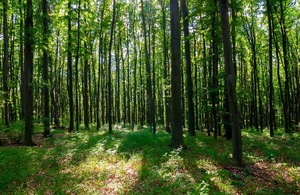Tree planting guide launched for farmers and foresters
New guide identifies 33 tree species best suited for planting on farmland

Hornbeam, beech, goat willow and walnut are just some of the tree species best suited to planting on farmland according to a new expert tree planting guide for farmers published today.
, which was developed by Forest Research in partnership with the University of Reading, provides information on 33 different species of trees and shrubs suitable for planting in UK agroforestry systems. This guide will help inform farmers鈥� tree species selections based on the individual needs and conditions of the farm.
Trees on agricultural land can offer a range of benefits, including protecting natural resources like soil, storing carbon, diversifying farm products with timber, fruits and nuts, and providing shade and shelter to livestock. Planting the right trees in the right place helps farms remain resilient to changing climate, diversifies the farm business and lessens exposure to fluctuating agricultural markets.
Species highlighted in the guide include hornbeam trees, which are suitable for most farm types, have great longevity and can produce specialised timber. Similarly, beech trees offer longevity and value for timber while also being suitable for upland farms and requiring little maintenance. Other alternatives include walnut and black walnut trees which,聽in addition to producing nuts, offer benefits to livestock, goat willow trees have great productivity benefits such as biomass and tannins, and common and red alder trees, which are able to capture nitrogen for farmers to help improve soil health and, ultimately, forage grassland. Every tree planted can absorb carbon dioxide, helping to mitigate the effects of climate change.
Forestry Commission Chief Executive Richard Stanford said:
鈥淔ood production and environmental goals are under increasing scrutiny and the effects of climate change are becoming apparent to us all.聽 Agroforestry can offer improved productivity from livestock and crops and help to build resilience to climate change.聽
鈥淭his indispensable guide outlines which tree species are most suited to farmers鈥� needs and the conditions specific to their land.
鈥淎 wide variety of trees are suitable for a range of situations from livestock farming to arable; this guide will help farmers, land managers and foresters enjoy the whole host of benefits incorporating trees into farmland while maximising food production.鈥�
Tom Breeze, Senior Research Fellow in Ecological Economics at the University of Reading鈥檚 School of Agriculture, Policy and Development, said:
鈥淔arming with trees is a great way for farmers to meet environmental goals without compromising food production, but the barriers to entry can feel overwhelming.
鈥淒rawing on years of research from the University of Reading, this guide aims to equip farmers with the practical knowledge and tools they need to get started.
鈥淥ur goal is to make farming with trees more accessible, increase awareness of its benefits, and spark a conversation about how agroforestry can transform agriculture in the UK.鈥�
There are a wide a range of grants available to farmers聽to support planting and maintaining聽trees on agricultural land. These include the Environmental Land Management聽(ELM)聽schemes which pay farmers and land managers for delivering significant and important outcomes for the climate and environment聽alongside food production, and include offers for establishing and maintaining in-field agroforestry systems. ELM also includes support聽and assistance for land managers in planning, creating, improving and managing agroforestry systems. Other support available includes the Forestry Commission鈥檚 England Woodland Creation Offer聽(EWCO), which provides 15 years of annual maintenance payments as well as standard capital costs and additional stackable payments.
As a farmer or landowner in England you can apply for a tree planting grant and reap the rewards of woodland creation now and for years to come. Further information, via our Put Down Roots campaign, can be found .
Additional information:
- , developed in partnership with the University of Reading through Defra鈥檚 Nature for Climate Fund Tree Planting Programme, follows consultation with a stakeholder group which includes the Forestry Commission, Natural England, the Woodland Trust, the National Trust and the Soil Association.
- More information on the benefits, types of agroforestry and the grants available to farmers who plant trees on farms is available in the Forestry Commission鈥檚 guide to agroforestry.
- EWCO proposals within low sensitivity areas may also be eligible for Woodland Creation Fast Track. Our delivery partners also offer competitive tree-planting grants and further support is also available in the form of advice and guidance, and delivery partners can also offer further help with completing grant applications, for example.
- Further information on the effects of climate change on UK woodlands, and guidance for practitioners to adapt their woodlands to increase resilience, is now available on the